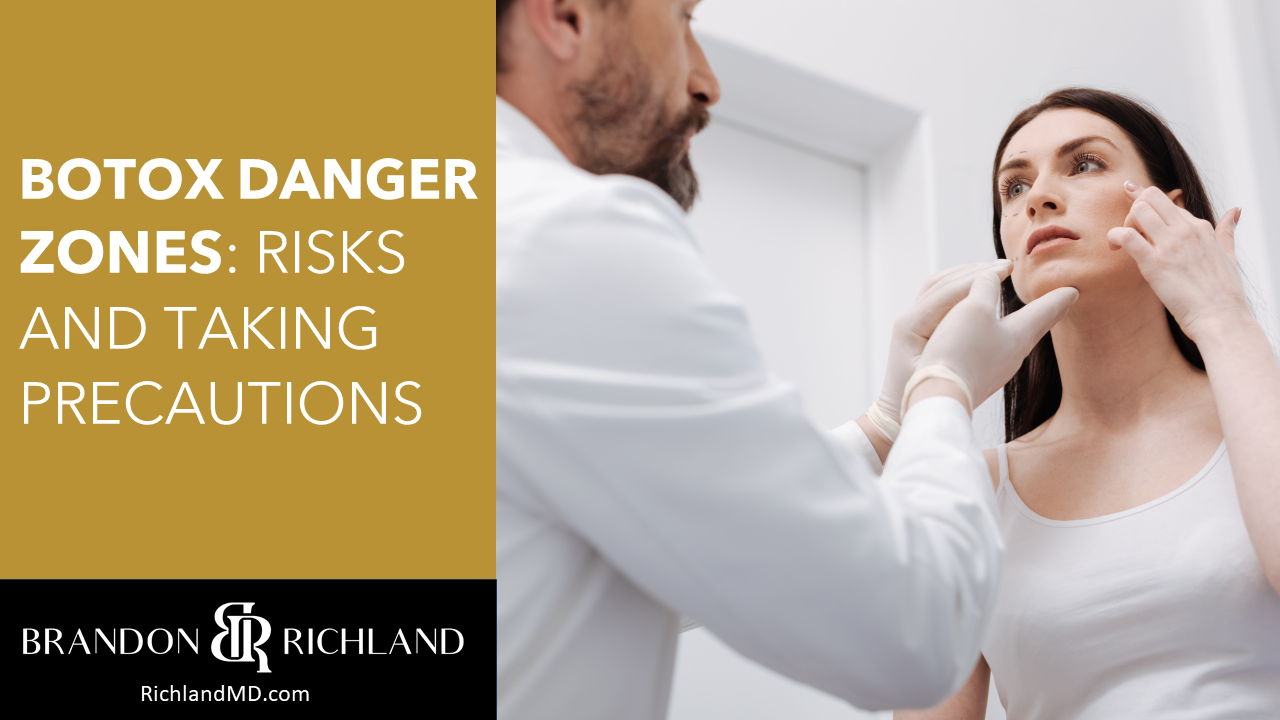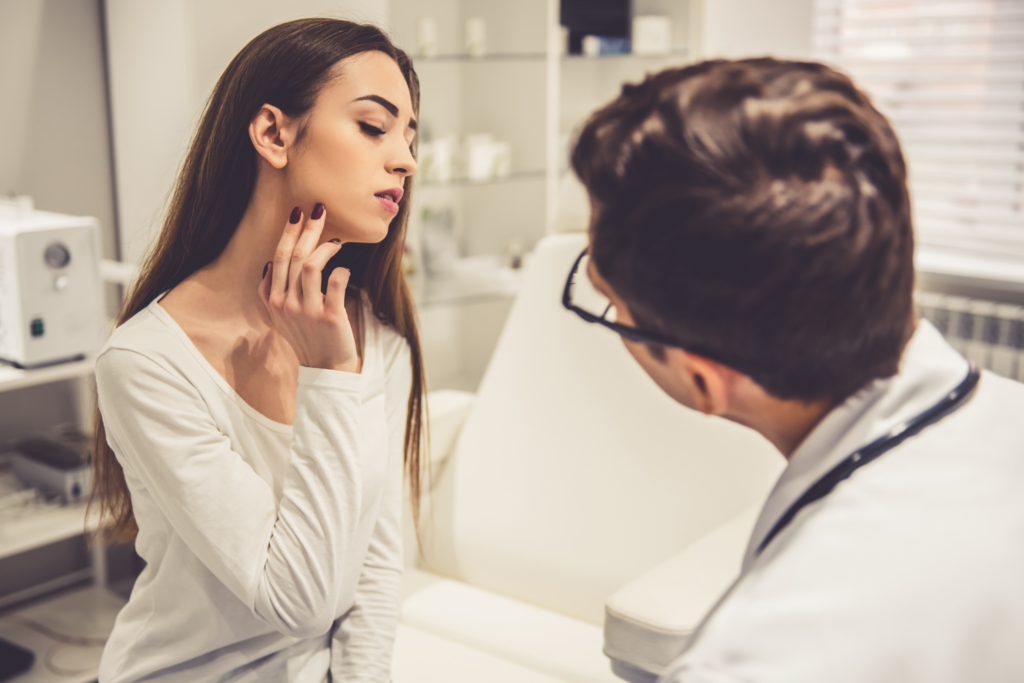Published by Dr. Brandon Richland, MD

Botox, a widely used cosmetic procedure, comes with its set of considerations for ensuring safe and effective treatment. While the benefits of this minimally invasive procedure are well-advertised, the potential for complications is an essential aspect for patients and practitioners to acknowledge. Understanding the anatomy of the face and the exact function of Botox is crucial before undergoing injections, as it helps in mitigating risks associated with the treatment.
Considered generally safe when performed by a qualified practitioner, Botox injections can still present challenges if not administered correctly. Areas of caution are termed ‘danger zones,’ where the risk of unwanted side effects increases
The precision of injection techniques and adherence to best practices are vital in avoiding adverse events. Choosing the right professional for Botox treatments is just as important as understanding the procedure itself to ensure health and satisfaction in the long term.
Key Takeaways of Botox Danger Zones
- Understanding facial anatomy and Botox’s role is crucial for safe injections.
- Precise techniques on how to inject Botox minimize risks in designated ‘danger zones.’
- Selecting a qualified practitioner is essential for a positive outcome.
Understanding Botox and Its Usage
Botox or botulinum toxin, is widely used in cosmetic procedures aimed at diminishing visible signs of aging such as wrinkles and fine lines.

The Basics of Botulinum Toxin
Botulinum toxin is a neurotoxic protein derived from the bacterium Clostridium botulinum. It is used medically to treat various muscular conditions, chronic migraine, excessive sweating and cosmetically to remove wrinkles by temporarily paralyzing muscles.
Botulinum toxin treatment works by blocking the neurotransmitter acetylcholine, causing muscle paralysis that smooths the skin and reduces the appearance of wrinkles and frown lines.
Common Cosmetic Procedures Involving Botox
Cosmetic applications of Botox are numerous, with the most popular being the reduction of frown lines between the eyebrows, smoothing of crow’s feet (lines around the eyes), and softening of wrinkles on the forehead.
By carefully injecting small amounts of the toxin into specific facial muscles, practitioners can help create a more youthful appearance. It’s essential that the practitioner is experienced and aware of the Botox danger zones to prevent complications.
Understanding the Anatomy
When considering Botox injections, understanding the anatomy of the face is crucial. Identifying potential danger zones and recognizing the significance of injection sites is paramount for both practitioners and patients to ensure safety and effectiveness.
Identifying Potential Danger Zones
The face contains several Botox danger zones where incorrect injections can lead to complications. These areas are highly sensitive due to the presence of complex facial muscles and nerves.
Common danger zones include regions around the eyes, such as the orbicularis oculi muscle, where improper application may lead to drooping eyelids. The forehead, where the facial artery and temporal artery are located, is another area where precision is essential to avoid unintentional consequences.
The Significance of Injection Sites
Choosing the right injection site is critical to the success of Botox treatments. Each injection must be carefully placed into targeted facial muscles to prevent unwanted effects and achieve desired results.
As the contours of facial anatomy vary from person to person, a tailored approach to selecting injection sites minimizes risks associated with potential danger zones. An injector’s expertise and knowledge of facial structures play a vital role in the safe administration of Botox.
Botox Administration
In Botox treatments, the precision of injection techniques and adherence to best practices are paramount for optimal results and patient safety. Practitioners with sound medical training are crucial for navigating these elements successfully.
The Importance of Precise Injection Techniques
Precise injection techniques are essential because they significantly reduce the risk of complications and ensure the effectiveness of Botox treatments. For instance, it’s well-understood that the forehead and crow’s feet areas can respond favorably to Botox, but even within these regions, the injection sites must be carefully chosen to avoid adverse effects such as drooping eyebrows or eyelids.
Ensuring Patient Safety and Comfort
Patient safety and comfort should be a practitioner’s top priority. A practitioner’s approach should be gentle and considerate, explaining each step to the patient to ease any concerns. This includes everything from the initial consultation to the post-treatment care instructions.
Botox Injection Danger Zones
In Botox cosmetic treatments, a precise understanding of facial anatomy is critical to ensure safety and effectiveness. Specific muscle groups, nerves, and arteries must be considered to avoid adverse outcomes.
Facial Anatomy and Muscle Groups
The human face has numerous muscles that control expression, and botox injections are used to relax specific ones to smooth out wrinkles.
Orbicularis Oculi Muscle: The eye area is delicate, surrounded by the orbicularis oculi muscle, which is responsible for blinking and closing the eyes. Incorrect injections can lead to droopy eyelids or, in severe cases, functional issues with the eyelids.
Glabella region: The glabella (space between the eyebrows) harbors muscles that contribute to frown lines. Over-treating this area can lead to a frozen look or asymmetry. The forehead, particularly the Frontalis muscle, should also be approached with care. Injections here affect eyebrow position and excess can result in drooping.
Nose Area: The dorsal nasal artery linked with the facial arteries and their related blood vessels. Incorrect cosmetic injections application in this region can lead to serious issues, including blindness, alar necrosis, or ocular ischemia.
Precise knowledge of nerves and arteries in the facial region is vital. One must ensure to avoid important nerves and the facial artery, as unintentional injections into these areas can lead to severe complications and an unnatural appearance.
Choosing the Right Practitioner
When considering Botox injections, selecting a practitioner with the proper qualifications and a deep understanding of facial anatomy is critical for safety and efficacy.

Qualifications and Experience
It’s essential that the practitioner administering Botox injections has a robust background in medical training and holds appropriate certifications. Ideally, they should be a dermatologist or plastic surgeon, as these professionals are specially trained in procedures that affect the skin’s appearance.
Prospective patients should verify that the practitioner is licensed to practice in their state and has a history of performing Botox injections with successful outcomes. Looking for practitioners who have been cleared to perform Botox treatments by the FDA adds an additional layer of reassurance about their commitment to safety and regulatory compliance.
Ensuring a Practitioner Understands Facial Anatomy
A practitioner’s understanding of facial anatomy is paramount to avoid Botox danger zones. It necessitates intricate knowledge of muscle structures and locations, such as the orbicularis oculi muscle around the eyes.
An experienced practitioner will be well-versed with the precise injection points that facilitate the desired smoothing effect without encroaching on areas that could affect facial expressions or blood flow. They should also be able to assess a patient’s unique facial structure to customize the injection plan, thus ensuring the treatment is both safe and benefits the individual’s aesthetic goals.
Comparing Botox with Other Treatments
When considering facial treatments for aesthetic improvements, it’s important to weigh the characteristics of Botox against other available options. The choice often comes down to the desired outcomes, potential risks, and areas of treatment.
Dermal Fillers and Their Uses
Dermal fillers are substances designed to act as a volumizing agent when injected beneath the skin. Unlike Botox, which relaxes the muscles, fillers are typically used to plump up areas such as the lips, cheeks, and under-eye hollows. They can provide a fuller, more youthful appearance.
Alternative Treatment Options and Considerations
Apart from Botox and dermal fillers, there are a myriad of other cosmetic procedures available, ranging from laser treatments to chemical peels. These alternatives may cater to individuals looking for non-invasive approaches or those whose skin concerns are not effectively addressed by botulinum toxin injections.
It’s crucial for patients to consider the complications tied to each treatment and to consult a qualified professional who can guide them toward the safest and most effective choice.
Frequently Asked Questions About Botox Danger Zones
1. What Are The Potential Complications From Botox in The Glabella Region?
Injecting Botox into the glabella, the area between the eyebrows, can lead to complications such as drooping of the eyelids or a frozen forehead if not done correctly by a skilled professional.
2. Can Botox Injections in The Neck Lead to Adverse Effects?
Yes, administering Botox in the neck can occasionally result in side effects such as difficulty swallowing or neck weakness, highlighting the importance of having the procedure done by an experienced practitioner.
3. In Which Scenarios Should Someone Avoid Getting Botox Altogether?
Individuals with certain neurological diseases, allergies to Botox ingredients, or skin infections at proposed injection sites should avoid Botox. Additionally, pregnant or breastfeeding women are typically advised to postpone treatment.
4. What Constitutes The Highest Risk When Undergoing a Botox Treatment?
The highest risk in Botox treatments arises from improper injection techniques, lack of anatomical knowledge, and use of non-licensed practitioners. For safety, always seek treatments from qualified healthcare professionals.

Conclusion and Summary of Botox Danger Zones: Risks and Taking Precautions
Botox injections, widely acclaimed for their cosmetic benefits, necessitate a careful approach to ensure safety and efficacy. Key to achieving positive outcomes is the selection of a qualified practitioner, who is not only skilled in these injections but also deeply knowledgeable about the facial anatomy to avoid complications and ensure the desired aesthetic results.
Given the range of potential side effects, from minor bruising to more severe complications like muscle weakness or ocular ischemia, patients must be well-informed and vigilant post-treatment. Adherence to post-injection care guidelines and immediate consultation in the event of adverse symptoms are paramount.
While Botox offers significant cosmetic advantages, its successful application relies on a blend of medical expertise, anatomical understanding, and patient cooperation. By prioritizing these factors, individuals can enhance their appearance with minimized risk, ensuring both health and aesthetic goals are met.
Please note that this article is intended for informational purposes only and should not be construed as medical advice. Before making any changes to your treatments, please consult with your healthcare provider to discuss the appropriateness and safety of such changes.
Ready For Your First-Class Cosmetic Experience in Orange County (OC) California (CA)?
Are you located in one of these Orange County (OC) / Southern California cities?
Aliso Viejo, Anaheim, Brea, Buena Park, Costa Mesa, Coto de Caza, Cypress, Dana Point, Fountain Valley, Fullerton, Garden Grove, Huntington Beach, Irvine, La Habra, La Palma, Laguna Beach, Laguna Hills, Laguna Niguel, Laguna Woods, Ladera Ranch, Lake Forest, Los Alamitos, Mission Viejo, Newport Beach, Orange, Placentia, Rancho Santa Margarita, San Clemente, San Juan Capistrano, Santa Ana, Seal Beach, Stanton, Tustin, Villa Park, Westminster, or Yorba Linda?
Plastic Surgeon Dr. Brandon Richland, MD and our Cosmetic Aesthetics Team are ready to help you look and feel your absolute best.
Elevate your confidence and self esteem levels to unfathomable new heights!
Schedule your in-person consultation in our modern and luxurious offices in either Fountain Valley, CA (Main HQ) or our Newport Beach, CA office.
Do you live outside of Southern California or short on time? For your convenience, Virtual Consultations are also available.
Our warm and engaging Team of carefully selected Aesthetics Professionals will make you feel calm, cool, collected, and right at home throughout your entire consultation and surgery process.
Schedule Your Aesthetics Consultation here, or call us directly at 949-867-4496 today.
About the Author

Dr. Brandon Richland, MD is a respected Board Certified Licensed Plastic Surgeon in Orange County / Southern California specializing in cosmetic and reconstructive surgeries.
Driven by his passion for medicine, Dr. Richland obtained his Doctor of Medicine (M.D.) degree from the prestigious program at Saint Louis University (SLU) School of Medicine in 2013. His exceptional skills were recognized when he received the McGraw Hill / Lange Medical Student Academic Achievement Award, and graduated top of his class with Honors. For his undergraduate degree, he attended University of California, Los Angeles (UCLA) and graduated with Honors in 2009.
To further enhance his surgical expertise, Dr. Richland completed his Residency in Plastic Surgery at the University of California, Irvine (UCI) from 2013 to 2019 earning the Academic Achievement Award twice during this period. A total of 14 years in dedicated schooling and medical residency.
Dr. Richland is actively involved with healthcare and medical societies, as a Diplomate of the American Board of Plastic Surgery, a member of the American Society of Plastic Surgeons, American Society of Aesthetic Plastic Surgeons, and the California Society of Plastic Surgeons.
Contact Dr. Richland today by visiting RichlandMD.com, scheduling a cosmetic consultation, or by calling 949-867-4496 directly.
Cover Image Credit: Zinkevych / 123RF.com (Licensed). Photo Illustration by: Dr. Brandon Richland, MD.










